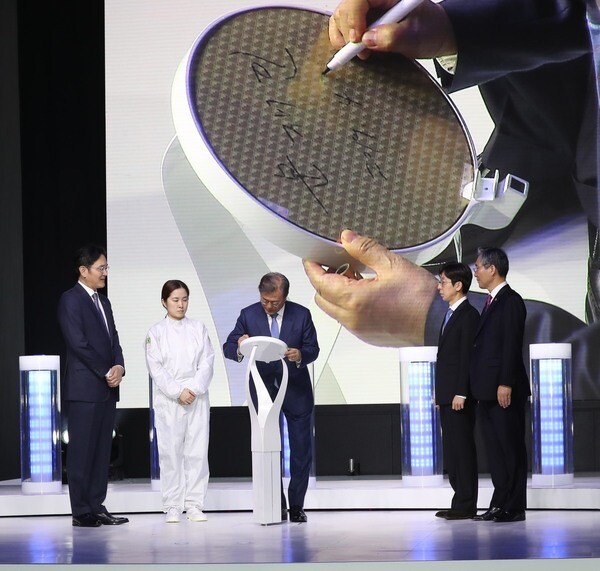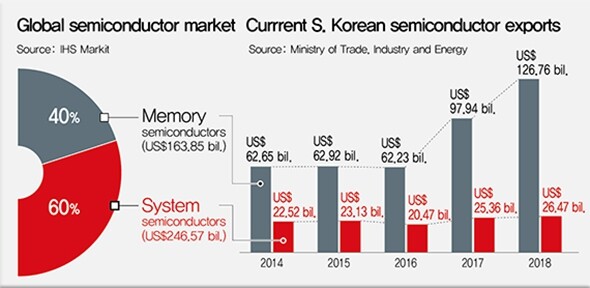hankyoreh
Links to other country sites 다른 나라 사이트 링크
Moon announces system semiconductor “vision and strategy” to match Samsung investment

The Moon Jae-in administration announced its own system semiconductor “vision and strategy” to align with Samsung’s announcement of investment plans. The measures are to involve restarting efforts to foster the system semiconductor industry, which have failed a number of times in the past due to overly optimistic predictions. The emphasis was placed on generating demand, with the administration and private corporations entrusting the necessary system semiconductor technology design to domestic fabless firms specializing in system semiconductor design – an area where creative technology is an important element.
On May 1, nine government ministries – including the Ministry of Trade, Industry and Energy (MOTIE), the Ministry of Economy and Finance (MOEF), the Ministry of Education (MOE), and the Ministry of Science and ICT (MSIT) – released a list of five “intensive countermeasures” in the area of system semiconductors, with the objection of achieving a 10% share of the fabless market, world number one status for foundries, and the creation of 27,000 jobs by 2030.
First among them is the fostering of fabless businesses as the key players in the system semiconductor industry, which involves small-scale production of a wide variety of items. Only one South Korean company – Silicon Works – is counted among the world’s top 50 fabless businesses, while 70% of the market is held by US companies such as Qualcomm, Nvidia, and AMD. The situation contrasts with the foundry market (commissioned production of designed semiconductors), where Samsung Electronics is in pursuit of the current global number one, Taiwan’s TSMC.

To foster the fabless industry, MOTIE and the Korea Electronics Technology Institute (KETI) signed a work agreement on Apr. 30 to establish “Alliance 2.0” with 23 companies in five areas, including Hyundai Mobis, Hyundai Robotics, LG Electronics, the Korea Electric Power Corporation, and Onetech. The aims of Alliance 2.0 are to locate system semiconductor demand and jointly pursue technology planning and R&D. The promising technologies that Alliance identifies are to be initially reflected in government R&D, amounting to 30 billion won (US$25.77 million) over a one-year period. The administration has announced plans to develop system semiconductors – which are necessary for public fields such as smart gas and electric metering, intelligent CCTV, 5G module electronic tagging, defense radar, smart highways – into a market worth over 240 billion won (US$206.18 million) by 2030.
Tax and finance support are to be provided to foundry companies, including Samsung Electronics. The government’s idea is to build a cooperative ecosystem where foundry businesses substantially open their processes, technology, and infrastructure to fabless businesses in exchange for support. The administration announced plans to train 17,000 specialized workers by 2030 through tuition support for newly created semiconductor contract departments at Yonsei University and Korea University, along with hiring pledges. Following a pre-feasibility study by MOTIE and MSIT, 1 trillion won (US$858.93 million) in R&D funds are to be used for development of artificial intelligence (AI) semiconductors and other next-generation semiconductor technology. A new dedicated fabless fund of 100 billion won (US$85.89 million) is to be created under private sector leadership. A dedicated fabless fund was also included in the system semiconductor strategy announced in 2015, but fell through due to failure to find private investors to fund it.
By Choi Ha-yan, staff reporter
Please direct comments or questions to [english@hani.co.kr]

Editorial・opinion
![[Column] Park Geun-hye déjà vu in Yoon Suk-yeol [Column] Park Geun-hye déjà vu in Yoon Suk-yeol](https://flexible.img.hani.co.kr/flexible/normal/500/300/imgdb/original/2024/0424/651713945113788.jpg) [Column] Park Geun-hye déjà vu in Yoon Suk-yeol
[Column] Park Geun-hye déjà vu in Yoon Suk-yeol![[Editorial] New weight of N. Korea’s nuclear threats makes dialogue all the more urgent [Editorial] New weight of N. Korea’s nuclear threats makes dialogue all the more urgent](https://flexible.img.hani.co.kr/flexible/normal/500/300/imgdb/original/2024/0424/7317139454662664.jpg) [Editorial] New weight of N. Korea’s nuclear threats makes dialogue all the more urgent
[Editorial] New weight of N. Korea’s nuclear threats makes dialogue all the more urgent- [Guest essay] The real reason Korea’s new right wants to dub Rhee a founding father
- [Column] ‘Choson’: Is it time we start referring to N. Korea in its own terms?
- [Editorial] Japan’s rewriting of history with Korea has gone too far
- [Column] The president’s questionable capacity for dialogue
- [Column] Are chaebol firms just pizza pies for families to divvy up as they please?
- [Column] Has Korea, too, crossed the Rubicon on China?
- [Correspondent’s column] In Japan’s alliance with US, echoes of its past alliances with UK
- [Editorial] Does Yoon think the Korean public is wrong?
Most viewed articles
- 1[Column] Park Geun-hye déjà vu in Yoon Suk-yeol
- 2Thursday to mark start of resignations by senior doctors amid standoff with government
- 3Kim Jong-un expressed ‘satisfaction’ with nuclear counterstrike drill directed at South
- 4[Column] ‘Choson’: Is it time we start referring to N. Korea in its own terms?
- 5N. Korean hackers breached 10 defense contractors in South for months, police say
- 6Will NewJeans end up collateral damage in internal feud at K-pop juggernaut Hybe?
- 7Why Korea shouldn’t welcome Japan’s newly beefed up defense cooperation with US
- 8[Editorial] New weight of N. Korea’s nuclear threats makes dialogue all the more urgent
- 9[Guest essay] The real reason Korea’s new right wants to dub Rhee a founding father
- 10[Column] Yoon’s first 100 days should open our eyes to pitfalls of presidential system